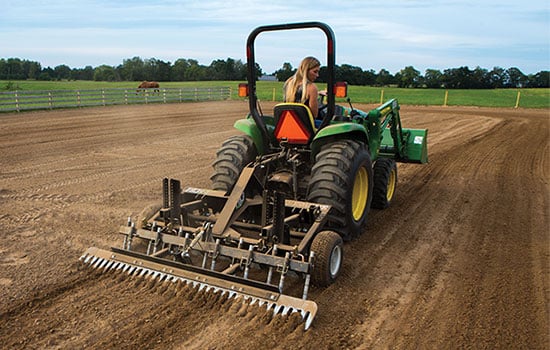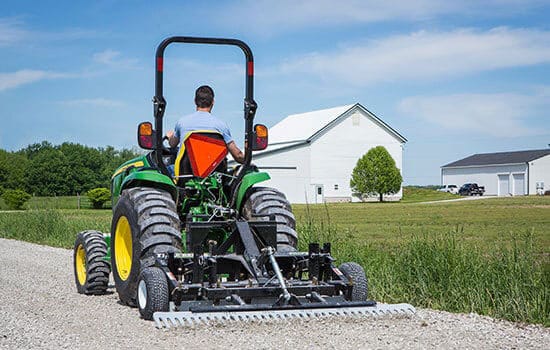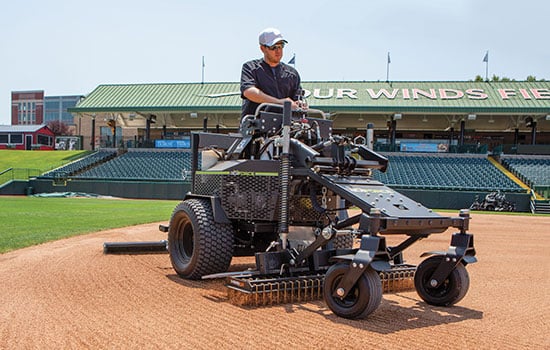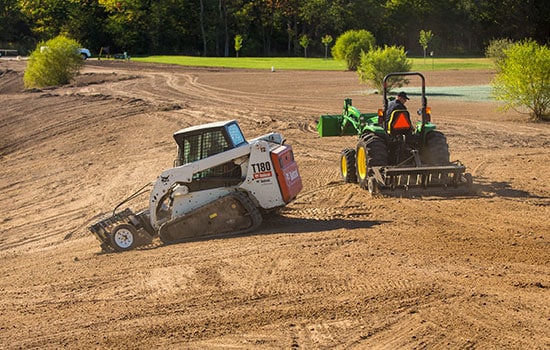Hydraulic vs. PTO – How to Power Tractor Attachments
How you plan on powering your tractor attachments is a large factor in some of the decisions you have to make when looking at a new or new-to-you tractor. In this episode, Matt walks through the two main ways of powering attachments, hydraulics and PTO, so you can be confident that your new tractor will be able to connect to and power both the attachments you currently own and the ones you may need in the future.
ABI Products Shown In This Video
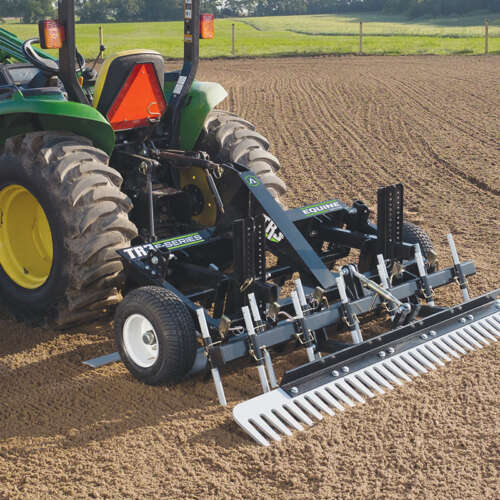
TR3 “E” Equine Edition
- For Sub-Compact & Compact Tractors, #1 Selling Arena Drag
- 6', 7', 8' Widths
- Starting At: $123/mo.*
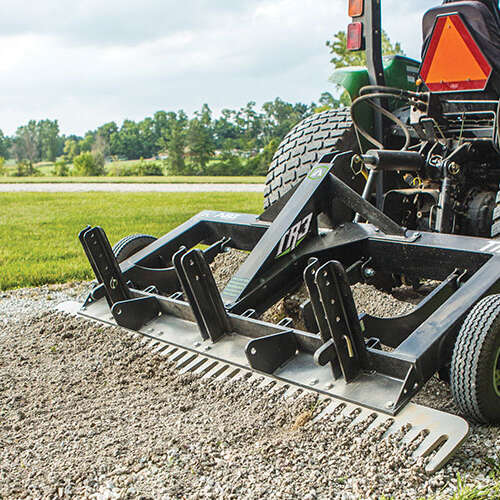
TR3 Rake
- For Compact & Utility Tractors
- 6.5', 7.5', 8.5', 10' Widths - Commercial-Duty
- Starting At: $116/mo.*
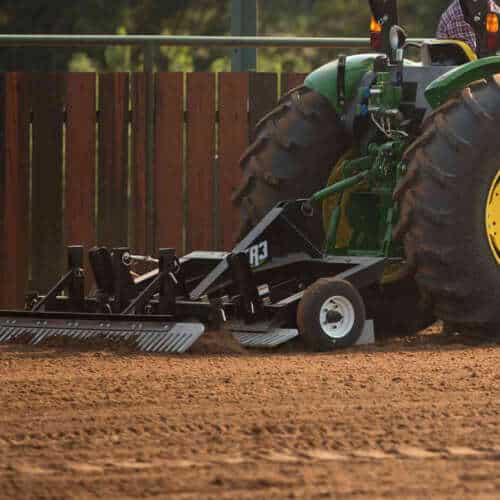
TR3 Rake Arena Drag
- For Compact & Utility Tractors, Extreme HD Arena Drag
- 5.5, 6.5', 7.5', 8.5', 10' Widths - Commercial-Duty
- Starting At: $116/mo.*
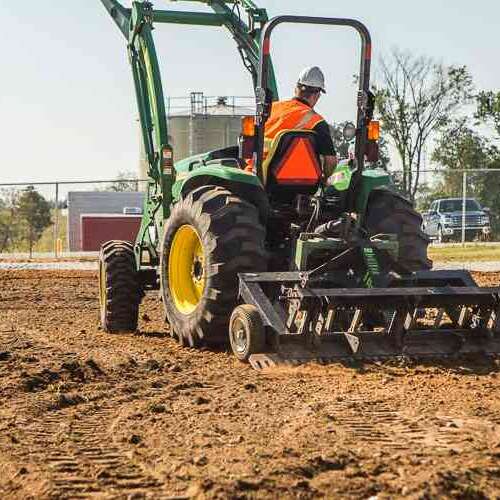
TR3 Grading Rake
- Commercial Contractor Landscape Rake
- 7.5' Width - Commercial-Duty
- Starting At: $184/mo.*
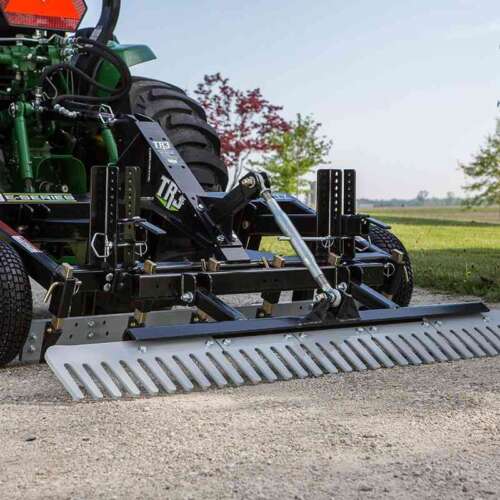
Transcript
Hi, everyone. Matt here with ABI Attachments. Welcome back to another episode of the ABI dirt. Today, you can see that we’re talking tractors. Now normally here on the ABI dirt, we talk attachments and we talk how those tractor attachments can make your life a whole lot better in your property management applications and in your horse arenas and on your ball fields. But today we’re taking a look at the tractors. This is actually part two of a three part series on tractors, because a lot of you have questions about tractors and the tow vehicle that you need to get the work done that you need to get done. If you didn’t catch our first episode in the series it means you’re not subscribed to the channel, which you can rectify that real fast, but subscribe to the channel. That way you don’t miss these episodes. Go check out the previous episode in the series on some kind of uncommon questions to ask and things to consider when you’re looking at a new tractor.
Today we’re actually taking a look at the the butt end of the tractor because the front end of color, doesn’t really matter. It’s the back end that matters when it comes to the tractor attachments that you need in attaching those attachments to your tow vehicles. We’re gonna take a look at tractor power sources and tractor connection types. So if you’re looking at a new tractor or if you’re looking at a new tractor attachment and you wanna make sure that you’ve got the right stuff in the right places to get the job done then we’re gonna take a look at that for you today.
Now there’s about a million different directions. We can take this conversation. I’m not doing a deep dive today for you on the back end of the tractor. There are a lot of really great channels out here on YouTube and a lot of really great companies provide a lot of great information on tractors. We are going to cover the basics for you today and I encourage you to do a deep dive for more information if you are still curious. Today we’re gonna break down the conversation into two, two different kind of chunks of info. The first is gonna be tractor power source. Second is going to be tractor connection type.
Tractor Power Source: PTO Vs. Hydraulic Driven Tractor Attachments
Now I’ve got here with me today, a John Deere four series and a John Deere one series tractor. There’s a lot of similarities, but there’s a lot of differences as well. And we’re going to see those. We’re gonna start with power source. If you’ve got an attachment that needs power to it somehow there is something on the out attachment that needs to move needs to go up and down or back and forth around and round, whatever it is. There’s something on that attachment that needs to be moved think mower or tiller or spreader or maybe you’ve got a power aerator of some kind that needs to be moving. That means you’ve got to apply power from your tow vehicle and somehow get that power to that attachment. Two primary ways with a third little guy way of how you get power from a tow vehicle to an attachment.
The two primary ways to get power to the back end is your power takeoff system. Now see the name and it gave it away. Didn’t it? Power takeoff system on your tractor and then also hydraulic system. So you can see here we’re gonna take a look at this John Deere four series. You can see and sorry, excuse our top link. You can see the power takeoff systems tucked back in there. This guy is well loved which is why that shield’s a little beat up right now. So power takeoff system up underneath that is the shaft that’s connected to the drive train that rotates super fast so that when you’ve got a power takeoff shaft connected to that you can take that energy, that motion to that attachment. So you can get moving whatever you need to get moving. You can also see here we’ve got our rear facing hydraulic ports on this tractor.
So when do you use one over the other? It really depends on the attachment that you’ve got. And I know, I know you tractor gurus out there. Sit with me. I know there’s a lot of ways with power beyond ports and other things to kind of use them interchangeably, but by and large general rule of thumb, if you’ve got something on your tractor attachment that is moving or spinning somehow you’re gonna be leveraging that power takeoff system because you’ve got the rotation of that power takeoff system, the rotation of the shaft. And then you’re going to some gearbox of some kind think rotary mowers, think tillers, think aerators, anything that you’ve got that is going to be moving constantly. We’ve got PTO spreaders here at ABI Attachments. Something that is moving continuously. That’s a great application for that power takeoff system. Whereas your tractor hydraulic quick connect system with these rear facing remote rear facing ports here on the back of this John Deere four series this hydraulic power is typically used for more intermittent power.
So when you’re thinking intermittent power think cylinders that have to go one way or the other let’s say that you’ve got a pole behind drag and we’ll get to connection types in a second. Let’s say you’ve got a pole behind drag that it needs to be raised and lowered off from the ground, right? So you’d have hydraulic cylinders then that are lifting up and dropping down the attachment or on our tier three SR3 line. We have got scar fires that can change depth on the fly into the ground for either gravel driveways, arenas. Those require hydraulic cylinders. We are going back to the the manure spreader example on our larger manure spreader models we have got in gates for those spreaders, that with the power of that hydraulic system, you can raise and lower that in gate to move it outta the way or have that down in transport position. So that’s the hydraulic system here. Now you’ll notice let’s switch over to our John Deere one series. When it comes to power sources or ways that the tow vehicle ways that the tractor can transfer power to the attachment, you’ve got your PTO shaft down there. This has that cute little rubber stopper on there, right? Because it’s a John Deere one series, who uses it. I’m just kidding. They, a lot of you use PTO systems on John Deere one series.
So that’s got that rubber stopper on there. The PTO shaft is down there. Look what we’re missing. We’re missing our rear facing hydraulic ports. Now this tractor does have a hydraulic system. If we scoot around there to the side, you’re gonna see that they are hydraulic remotes on the front, kind of mid mount of this John Deere one series. The typically on a tractor this size we consider this a subcompact tractor. The tractors this size are designed for mid mount typically a large mower bed. And you’ve got your front loader up there which is great. That’s fantastic. But if you’re looking at a subcompact tractor please make sure to ask your sales rep take a look at the specs online, or get your hands on it and take a look. Are there rear facing hydraulic ports? Because if you don’t have rear facing hydraulic remotes and you want an attachment that needs some kind of hydraulic power to that attachment that’s gonna cost you back in the dealership. And we, unfortunately we run into that quite a bit around here that somebody will call up and say, hey, I really love my new attachment. I can’t hook up the hydraulic system. I don’t have rear facing remotes and that’s really unfortunate. So it is possible. It is possible if you talk to your tractor dealership or your service dealership of choice, it is possible to add on that hydraulic remotes to the back end, after the fact, after purchase. It’s just, it’s not a fun process.
Connection Types: 3 Point Quick Hitch for Tractor Implements
So if you think that you’ve got a property or a job site or you’ve got life goals big enough that need an attachment that has the ability to maneuver components on that attachment hydraulically make sure you’re taking a look at a tractor that provides you those rear facing remotes and that you’ve got the right number of them. Because once we get up to this four series, you saw this four series has one set, right? So two remotes in the back, but the bigger the tractor, the bigger attachments. It might be beneficial for you to have more than one set of remotes. So that’s the power sources. Let’s talk next about hitch types. We’re actually gonna stay here in this John Deere one series because what’s really prominent here right up there in your face. You’ve got, when it comes to hitch types, connection types on your tractor, you’re looking at three point which is here three points. I don’t have three arms. Otherwise I’d all three at the same time. And you also have tow behind hitch options right down there. This is a great example for a subcompact setup, because this is considered a category one. And if you’re not familiar with your three point categories, website that I love to use, it’s called tractordata.com. There’s no affiliation. They don’t know me there. So you can say, tell me, tell ’em I said hi, but they don’t they know who I am.
They’ve got some great information on tractordata.com. Not only about tractors tow vehicles, but also if you look into the support material that talks all about the measurements of how big of pins are used in top and bottom locations on three point and what are the measurements from left to right? And whats to the spacing? Really great info there to help you understand the categories of three point hitches, but what the bare bones of it is that you’ve got three points of contact with the attachment which allows the tractor to lift the attachment all the way off the ground. Whereas your little guy down here, again on the subcompact tractor, that guy right there is your tow behind hitch. And that’s what you’ve got to work with dropping your hitch pin in there so that you can maneuver pull behind vehicles. On the contrary, if you look over at the four series here you can still see this three point hitch. Again, this one looks a bit different, because on this bigger model we have got our hydraulic cylinder our hydraulic top link which you’ve got a whole episode on that as well. Go check that episode out. We’re big fans of the hydraulic top link around here. Gives you a lot of control of your three point attachments.
Now that does mean though, for those of you who are being extra perceptive, given that it’s a hydraulic top link we are using are two hydraulic remotes to manhandle this thing. So that means then if we’re connected to an attachment that requires, or we want it to have, some hydraulic motion to it, some cylinder, some hydraulic cylinders or whatnot our ports are already used up. So again, keep it in mind if you’re looking at three point attachments and you like the control nature of the ability to control that this hydraulics gives you, two remotes may not be enough. But you can see here on this four series you’ve got this big three point here and you also have a much larger tow bar, much larger draw bar down low.
Now I’d love to go into the pros and cons of three point versus to behind. But that’s actually next episode. For now, make sure to leave us some questions below. If you’re curious about anything I’ve said so far, about connection types, or about power types, hydraulic versus your PTO tractors, or if you just wanna share with us what you’ve got going on in your property maybe your favorite tool that uses hydraulic remotes or a power takeoff system, leave it in the comments. Ask us some questions and we’ll be back with you next time. Thanks everyone.
